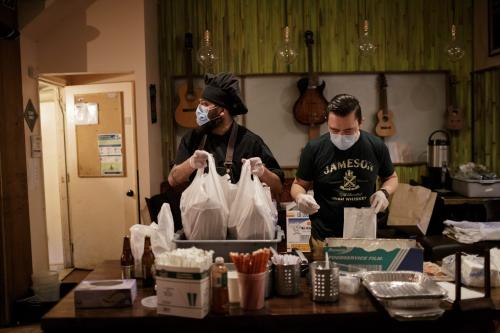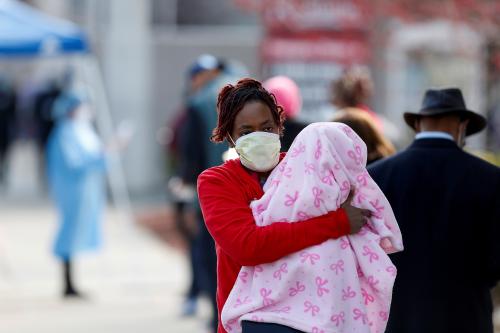Between the armed COVID-19 “reopening” protests, President Donald Trump’s threat to withhold pandemic relief funds over vote-by-mail efforts, and invectives referring to Governor Gretchen Whitmer as “that woman,” Michigan isn’t just a battleground state in 2020—it feels like an actual battleground.
Sadly, the smoke of this political firefight obscures the sum of lives and jobs Michigan has lost to COVID-19. The coronavirus’s spread here illustrates the dual contagion in both health and the economy, as highly interconnected global supply and distribution chains—in autos, food, and many other products—are disrupted. As seen in the table below, Michigan suffered greater job loss in April than states in the pandemic-ravaged Northeast, as well as those almost entirely dependent on tourism.
Table 1: States with the steepest March-April employment losses
| State | March | April | Job Loss | % Drop |
| Michigan | 4,422,800 | 3,413,800 | -1,009,000 | -22.8% |
| Vermont | 309,400 | 248,700 | -60,700 | -19.6% |
| New York | 9,723,100 | 7,895,800 | -1,827,300 | -18.8% |
| Hawaii | 654,300 | 532,500 | -121,800 | -18.6% |
| New Jersey | 4,166,800 | 3,409,100 | -757,700 | -18.2% |
| Rhode Island | 498,500 | 409,700 | -88,800 | -17.8% |
| Nevada | 1,404,600 | 1,159,800 | -244,800 | -17.4% |
| Massachusetts | 3,668,800 | 3,045,800 | -623,000 | -17.0% |
| Pennsylvania | 6,038,300 | 5,014,200 | -1,024,100 | -17.0% |
| Delaware | 465,300 | 390,600 | -74,700 | -16.1% |
Source: U.S. Bureau of Labor Statistics, State and Metro Area Employment, Hours, & Earnings. Employment refers to total nonfarm payroll jobs.
At the same time, COVID-19 has wrought havoc on vulnerable populations in the state. Michigan has the fifth-highest death toll, and more than three-quarters of coronavirus-related deaths have taken place in greater Detroit—the lifeblood of economic opportunity for many people of color who came north during the Great Migration or fled violence in the Middle East.
Recent decades have not been kind to this region or its people, with trade, the transition to a service-dominated economy, and a decline in unionization bringing deindustrialization and job loss. For those fortunate enough to have a job for an automaker or a first-tier parts supplier, a middle-class lifestyle is still available. For many others without a college education, few decent alternative jobs are within reach. As a result, poverty and poor health are common. And COVID-19 is going to make it worse.
Even when the pandemic abates, Michigan’s manufacturing-intensive regions will still face some of the most severe recovery challenges. The state’s workers and families are more likely to see deeper and extended economic impacts from the COVID-19-induced recession, which is not only pulling the plug on many production jobs, but also halting work in many small businesses downstream.
Many of those jobs and businesses won’t come back. Plenty of restaurants and personal service small businesses also may not survive, but starting new firms in those industries will be less of a challenge as the economy recovers. Rebuilding complex supply chains in manufacturing, however, is much more difficult, with bigger implications for the creation of downstream jobs. Moreover, history shows that a deep recession also will accelerate disruptive automation and change the skills demanded by employers. This poses a particular challenge for Michigan and other Rustbelt states with aging workforces that lag in rates of postsecondary education.
These disruptions help explain why Michigan is the state with the largest share of its workers unemployed due to COVID-19. But it also explains why the state tops the country in its share of unemployed workers seeking and receiving jobless benefits.
As we’ve detailed previously, unemployment insurance (UI)—in which employers pay into a fund that supports workers when they are temporarily laid off through no fault of their own—became a federally sponsored (but state administered) program in 1935. Born from the Great Depression, it was established to provide temporary income support to full-time workers in highly cyclical industries who were idled or had to search for a new job.
Since then, the program has occasionally been expanded. In 1970, disaster unemployment assistance was created to assist workers suffering from a government-declared disaster but were not eligible for normal UI. This extension formed the basis for the CARES Act’s Pandemic Unemployment Assistance, temporarily allowing self-employed, gig, and contract workers to collect unemployment insurance (in most states at least), as well as additional federally funded benefits of $600 weekly through July. More recently, several states have adopted short-time compensation or work-sharing, allowing employers to spread out work reductions by reducing the hours of employees, who are then able to collect prorated unemployment assistance.
Michigan’s high rate of benefit receipt reflects the state having more workers in the types of jobs that UI was designed for. Claims in our state were disproportionately driven by manufacturing (and specifically auto-related manufacturing) relatively early on in the crisis, and slightly later by construction.
Despite the overall drop in union prevalence, these cyclical industries are still highly unionized in Michigan, and unions often assist and educate their members in applying for unemployment benefits in downtimes. Other states with high unemployment rates in April, such as Nevada and Hawaii, depend on service jobs in travel and tourism, and workers there likely had less experience with the unemployment system. Michigan’s rapid ramp-up in claims also stemmed, in part, from Governor Whitmer’s executive order to expedite the application process by waiving some of the normal eligibility and work search requirements. These waivers are permitted by the CARES Act, but not all states have used them.
The COVID-19 pandemic has been like a giant social X-ray, exposing many truths. In Michigan, it has revealed the persistent dependence of the state’s economy on manufacturing. But it also means that our unemployed workers got assistance faster, possibly ameliorating the dip in spending relative to other hard-hit states. In this regard, Michigan may have lessons on the urgency to provide more support and economic security for workers navigating the continuing economic crisis.







Commentary
Why COVID-19 hit Michigan so hard
June 4, 2020